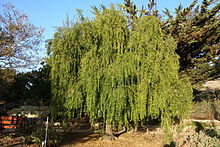Maytenus boaria
| Mayten | |
|---|---|
 |
|
| Maytenus boaria | |
| Scientific classification | |
| Kingdom: | Plantae |
| (unranked): | Angiosperms |
| (unranked): | Eudicots |
| (unranked): | Rosids |
| Order: | Celastrales |
| Family: | Celastraceae |
| Genus: | Maytenus |
| Species: | M. boaria |
| Binomial name | |
|
Maytenus boaria Molina |
|
Maytenus boaria (mayten) is an evergreen tree of the family Celastraceae, native from South America, up to 20 m (66 ft), 80 cm (31 in) diameter, straight trunk. It occurs naturally approximately from 30 to 50ºS: Chile and Argentina.
Its leaves are small, alternate, elliptical, fine serrate margins, light green color, about 2.5 and 5 cm long. The flowers are small; male flowers are brownish yellow and female are green with purple lines. Its fruit is a yellow bivalve capsule, which contains one or two seeds, and is covered by a red-colored membrane. Its seeds are easy to germinate.
From its seeds oil is obtained in order to elaborate varnish. The hard wood is used in tool handles and as both ornamental in gardens and reforestation of Chile. Flowers combined with European bees produce a very delicious honey. Its tender leaves are used to feed cattle, in fact the name boaria means bovine, because they enjoy feeding from them. It is easy to plant by seed. It is fully naturalized in New Zealand. Few trees have been planted in gardens of California and private collections in Spain, and all of them have acclimatized in those lands. It has been planted in the North Pacific Coast of the United States as far north as Seattle, Washington.
It is slow-growing and drought resistant tree. When growing wild in Argentina, a more continental climate, it is hardier than those in Chile; but provenance source has not been selected from Argentina for cultivation in Europe.
In Argentina it's found also in Córdoba Province (an area with a continental climate and a dry season in winter), growing among Polylepis australis, a tree endemic of the central-pampean mountains of Argentina.
...
Wikipedia
